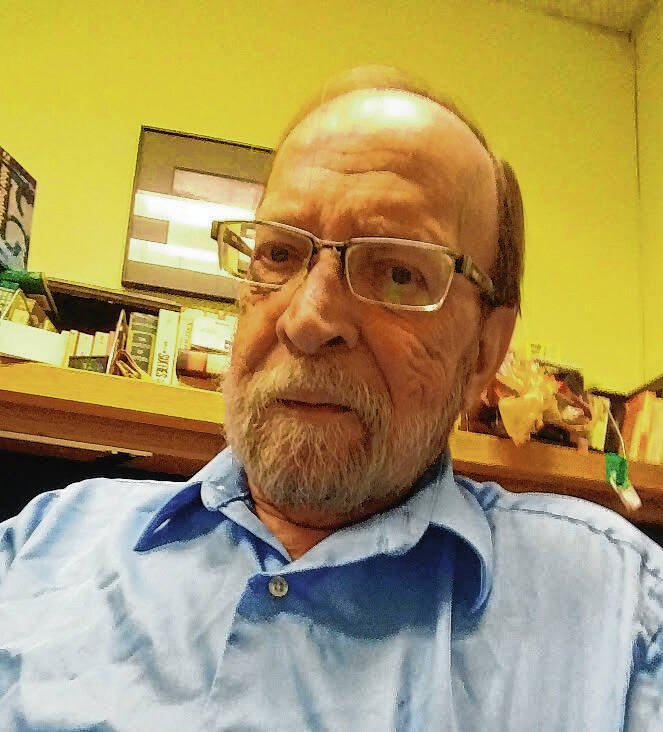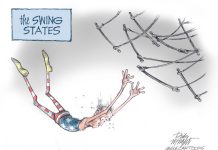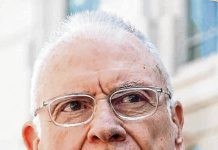Two pictures of Indiana.
The first picture, from the past.
Sylvanus Freelove Bowser was born in 1854 just north of Fort Wayne and, except for a short stay in Kansas, lived in that city for his whole life.
According to a 1963 issue of Old Fort News, Bowser was one of 13 children and had barely a year of formal schooling, his manual labor being needed to help support the family. He married in 1876, fell into debt and lost his house before suffering a nervous breakdown. Unable to cope with work for more than three or four days at a time, he became a traveling salesman.
Then, one day in 1885, he drew a day’s supply of water for his wife before heading off on his sales route. There must be a better way, he thought, than to haul up water in a bucket from a deep well. So, he came up with a pump that dispensed water through a flexible hose from a 50-gallon storage tank housed in a wooden box.
Bowser had a sudden insight – could this pump also handle kerosene, which grocery stores sold from wooden tanks in basement corners? So, he went out and sold the idea to his customers and ended up with five orders for a product that did not yet exist.
Three months later, Bowser, his brother and his nephew completed the first pump, which was delivered to Jake Gumpper, a Fort Wayne grocer from whom the broke Bowser needed credit for groceries. The self-contained unit could dispense a precisely measured amount of kerosene easily and safely, and the places where they were located became known as filling stations.
And in the next few years, the pumps began dispensing gasoline as the nation’s long romance with automobiles took hold. In the early days, motorists had to search far and wide for the fuel. Some cars even had compartments for storing cans of the stuff so that drivers would not be stranded on the road somewhere.
Bowser made modifications to the pump so it could be placed outside instead of indoors, and filling stations became gas stations, which became service stations, which became the convenience stores we see today every few miles on every interstate in the country.
He was the right man with the right idea in the right time and place. Before the Great Depression wiped him out, the barely educated traveling salesman had amassed a fortune of $4 million, about $82 million in today’s money.
The second picture, from the present.
The federal infrastructure law from last year dedicated $7.5 billion – $5 billion for the states – over the next five years to develop a nationwide network of 500,000 high-volume, rapid charging stations for electric vehicles.
Indiana gets $100 million of that, and will face the same difficulties as other states in getting in tune with the plan.
For example, from Route 50, a site dedicated to state and local governments: “Currently, many vehicles use different connections to attach to chargers. Plus, charging companies have used proprietary payment methods, rather than the pay-at-the-pump system drivers of gasoline-powered vehicles are used to. Charging stations sometimes even use different units when setting prices, with some using kilowatt-hours like an electric meter on a house and others to relying on minutes the vehicle is hooked up to the charger.”
Other questions abound. How will private investment be incentivized? The state won’t want to run the charging stations, and it will cost about $100,000 to install one. How will electric vehicles be taxed to make up for the lost gas tax revenues as internal combustion engines are replaced? Will the cost of an electric vehicle come down so they are affordable to the average consumer without a federal subsidy?
Indiana also has a problem not faced by every state. Its preliminary plan calls for most Hoosier motorists to be no more than 35 miles from a charging station and rural residents no more than 50 miles. Furthermore, 60 percent of the stations would be in disadvantaged or rural areas. But that’s not good enough.
“Few of those communities are racially or ethnically diverse,” complains one of the groups challenging the plan for being too beneficial for white communities.
The government says there will be 27 million electric vehicles on the road by 2030. Clearly, we are looking at one of the most ambitious programs in history that will take a coordinated, efficient and sustained effort by private business and all levels of government. The federal share alone is said to be at least twice what is already dedicated.
Currently, electric vehicles account for about 5% of the market. In Indiana, it is less than 1%.
That’s it, two pictures of Indiana.
I will leave it for you to decide what they mean.
Leo Morris, columnist for Indiana Policy Review, is winner of the Hoosier State Press Association’s award for best editorial writer. Morris, as opinion editor of the Fort Wayne News-Sentinel, was named a finalist in editorial writing by the Pulitzer Prize committee. Contact him at [email protected]. Send comments to [email protected].





